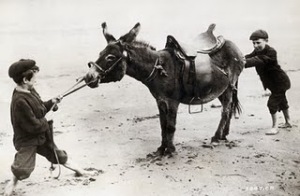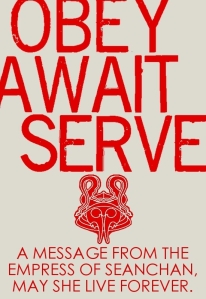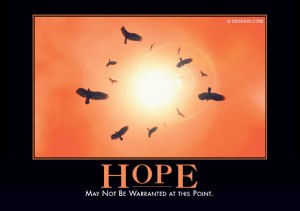 Wheel of Time 13: Towers of Midnight by Robert Jordan and Brandon Sanderson
Wheel of Time 13: Towers of Midnight by Robert Jordan and Brandon Sanderson
This is it, folks. We’re nearly done. Hang in there….
I’m finding this book tough to review for a few reasons. Firstly, reviewing it is kind of like preaching to the choir – if you’ve read this far into Wheel of Time then you really don’t need me to tell you that you ought to read this book. You probably already have, maybe more than once. If you haven’t started the series, there’s so much information you need to know in order for this book to make sense that this review will have no real significance for you. So I’ll just have to tell you what I thought and hope that’s enough.
Be warned: Spoilers ahead. I’ll try to keep them to a minimum, but they’re there.
As with all the Wheel of Time books, a lot happens in this volume. Some of the events have been anticipated by the fans for more than a decade, others are wonderful surprises. Either way, they’re setting us up for what I expect to be the Mother of All Finales when A Memory of Light comes out.
Let’s begin with Perrin, since he gets the most page time in this book. He has rescued his wife from the Shaido Aiel, along with a city full of refugees and former prisoners. Despite what he wants, these people look to him to be their leader, something he wants no part of. He just wants to send everybody home, forget that he was ever called the Lord of the Two Rivers, and go back to leading a normal life. But the Wheel won’t let that happen. Perrin Aybara is ta’veren, one of those individuals who both shape and are shaped by the Pattern, and what he wants doesn’t much figure into it.One of the issues I’ve had with Perrin, actually, is this steadfast, stubborn ignorance of what and who he truly is. For many books now, he’s been going through this whole “I just want to be normal” phase, when it’s obvious to everyone else – his wife, the people traveling with him, the dead wolves he talks to, to say nothing of the readers – that Perrin can never lead a normal life again. As with real people, it’s frustrating to see them deny what’s so clearly true, and that was one of the reasons why Perrin has never been my favorite character.
He turns around on that in this book, however. He does finally start to make peace with who and what he is, and understands his duties to the people who follow him. With that understanding comes strength – the strength to win over his greatest enemies and to master the abilities available to him in the World of Dreams. Perrin is finally coming into his own as both a leader and a warrior, and it will be good to see him look forward to the future instead of long for a past he can’t have anymore.
Mat is another who has been getting under my skin. While I love the way that Sanderson writes him – much funnier, more sarcastic, more modern than Jordan wrote him – he also wants nothing more than to opt out of the role that fate has decreed for him. Through his travels, he has been granted centuries of knowledge about battle and war, he has gone toe-to-toe against creatures that literally defy human understanding, and has a power over luck and fortune that has saved him more times than he can count. Yet he still resists the destiny that is clear to everyone else – to be a leader in the Last Battle.And that battle is definitely coming soon. Vast armies of Shadowspawn are overwhelming the northern defenses, turning whole cities into killing grounds. Food is rotting at a rapid rate, sometimes as soon as it is prepared. The very fabric of space and time is twisting, moving things around randomly. Rooms, streets, entire villages might shift and vanish in the night. The Dark One is nearly free, and there are very few options open when it comes to stopping him.
Rand al’Thor, the Dragon Reborn, has one idea – to break the seals of the Dark One’s prison so that it may be re-sealed. Rand’s opinion, however, is not very well regarded at the moment. Despite being the prophesied warrior on whose shoulders the fate of the world rests, he’s been kind of an unpredictable nutjob of late. In an attempt to be ready to save the world, Rand tried to distance himself from all emotion, all ties to the world, so that he could be hard enough to do what must be done when the End Times come. He has done terrible things in the name of What Must Be Done, which has led some to fear that the world would be doomed regardless of who won the final battle.
He’s feeling much better now, though. He has come to a state of understanding that should allow him not only victory against the Dark One but also peace. Unfortunately, it’s going to take some time to convince others of that, especially Egwene – formerly the Girl Next Door, now the Amyrlin Seat, leader of all Aes Sedai.
Having ended the internecine feud within the White Tower and begun the process of reconciliation, Egwene finds herself at odds against Rand and those who follow him. She agrees with his ends – victory over the Dark One – but not his means. If necessary, she will stand against the Dragon Reborn all the way to the end of the world.There’s so much more, too. There are action scenes between Mat and the vicious gholam that made me wish I had an animation studio at my disposal. A heartbreaking reunion between father and son. A terrible vision of the future of the Aiel, should things continue the way they are. Ragtag armies barely holding their own, people who we thought were dead revealed to be alive, sons reunited with their mother, battles against the forces of darkness, mislaid messages, a daring rescue, a growing army, and so, so much more.
The complexity of Wheel of Time is understandably off-putting for a lot of new readers, but I think Sanderson is doing a very good job at putting all the pieces together. We are now on the brink of the end, ready to dive into the Last Battle and the much-anticipated Fourth Age. Questions will be answered, people will live, nations will die, and the Wheel of Time will turn.
Stick with me folks, it’s only going to get better.
——————————————————————-
“After what we went through together, it turns out that she’s Morgase Trakand. Not just a queen – the Queen. The woman’s a legend. And she was here, with us, serving us tea. Poorly.”
– Alliandre, Towers of Midnight
——————————————————————-
Robert Jordan at Wikipedia
Robert Jordan at Tor.com
Towers of Midnight at Wikipedia
Wheel of Time at Wikipedia
Towers of Midnight at Amazon.com
Wheel of Time discussion and resources (spoilers galore):
Theoryland
Dragonmount
The Wheel of Time Re-read at Tor.com
The Wheel of Time FAQ
Wheel of Time at TVTropes.com












































